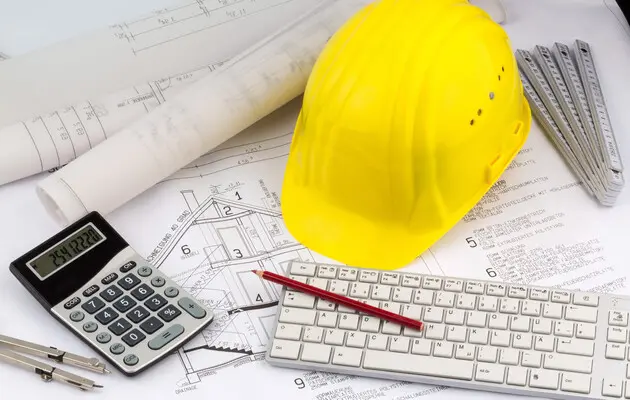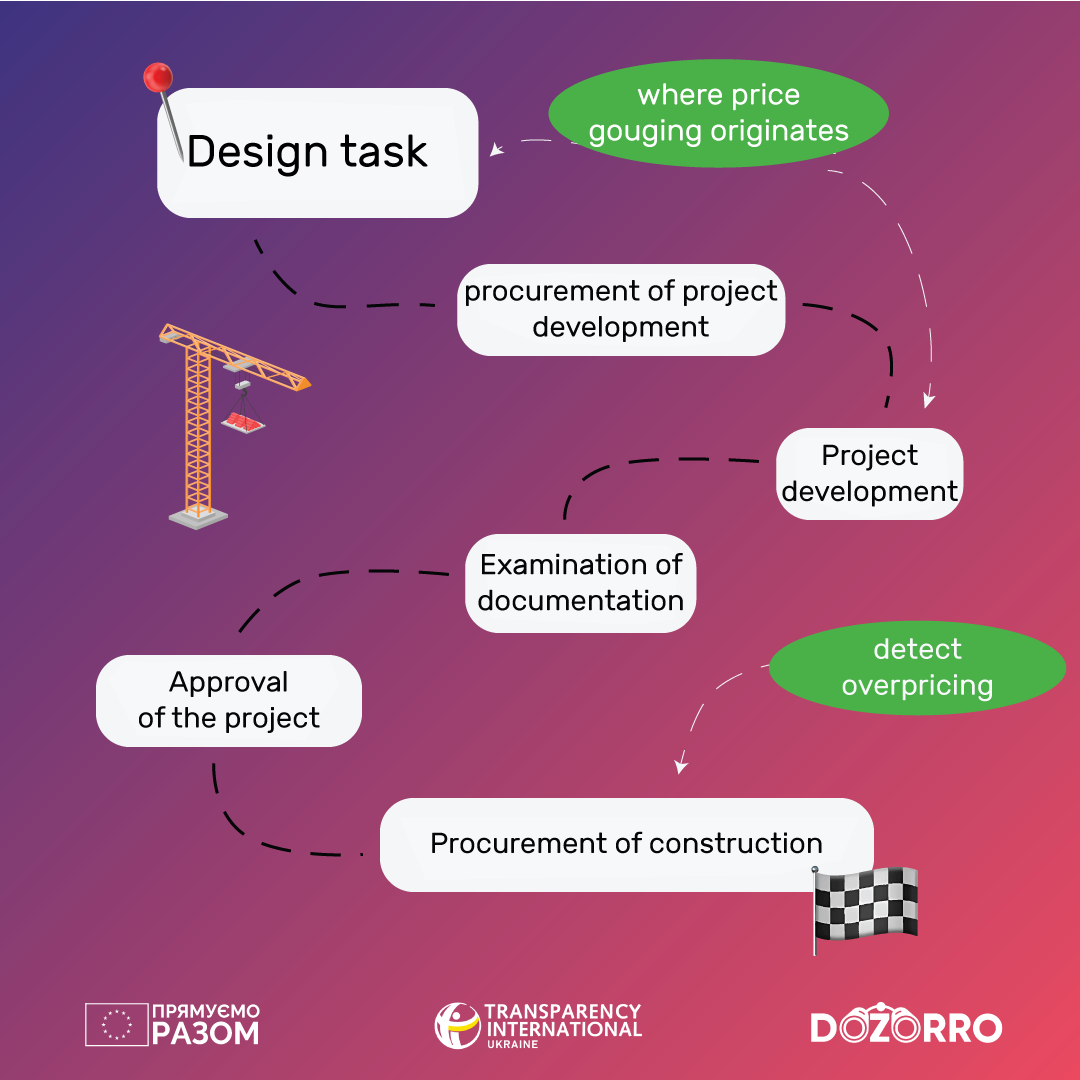Construction Tenders: Who Benefits from Overpriced Cost Estimates, and Why
Only in the first half of 2024, the DOZORRO team identified almost 130 million UAH of potential overpayments in construction tenders. Let's figure out why and when these overpayments happen and how to prevent them.
For the first half of 2024, the DOZORRO project identified almost UAH 130 million of potential overpayments in construction tenders. In fact, every thirteenth hryvnia in the contracts we monitored is an overpayment. The overpayments are more than 39 million UAH spent on the insulation of buildings and 5 million on shelter in Dnipropetrovsk region, more than 2 million on the lyceum and almost 10 million on the Center for the provision of administrative services in Vinnytsia region, about 2 million UAH on the hospital in Zhytomyr. This is only the beginning of the list because the problem is not local, on the contrary, it covers every region.
Why does this happen?
Construction is a regulated industry, where any technological process is preceded by a large layer of preparatory work: planning, obtaining permits, preparing project documentation, conducting an examination, approving the project, selecting a contractor at a tender. The question arises at what point do construction prices become inflated?
Usually, we pay attention to the last stage and look for overpayments and those who are guilty of it there. Bidders, namely construction companies, inflate the prices of building materials. However, they overestimate them because they can do it, because the expected purchase price allows it. After all, the business is looking for an opportunity to earn, so it offers its price within the expected cost. Actually, the expected cost of construction, which is determined by the customer, is the maximum amount that the person is ready to pay.
How are expected costs formed?
At the first stage, the customer must draw up and approve the design task. This is an important document that defines the main requirements for all project solutions, basic parameters, cost, and organization of construction. It is developed on the basis of urban planning and technical conditions, state building regulations, therefore it requires a high level of qualification. The quality and correctness of its planning determine the fate of the entire design and, as a result, construction.
Not every customer has design engineers among its staff. Sometimes specialized specialists are engaged on a contractual basis, but there are few such purchases at Prozorro. We suspect that it is at this stage that corruption schemes can begin. For example, customers can entrust the preparation of a design task to a project organization that should win the tender, and payment for these works is already included in the expected cost.
It is worth noting that there is a conflict between public design procurement under this scheme and urban planning legislation. In accordance with Part 9 of Article 29 of the Law "On the Regulation of Urban Development Activities", the assignment for the design of construction objects is drawn up and approved by the customer in agreement with the designer.
That is, theoretically, there cannot be a final design task until the designer is determined based on the results of the tender. Thus, the tender documentation is a kind of "dynamic" document that fundamentally affects the conditions of work performance and opens up a number of opportunities for manipulation depending on whether a "familiar" or "stranger" bidder wins the bidding.
After the stage of pre-project work, the customer purchases work on the development of project documentation. According to the signed contract, the selection of project solutions, the preliminary calculation of construction costs, including materials, is carried out. Such information is reflected in the investor estimate.
The final stage of designing is a mandatory examination of the project and its approval. As part of the examination, it is determined whether the project meets the requirements of the legislation. Often, customers entrust the project developer with the obligation to pass such an examination. He, like the customer, is interested in getting a positive conclusion as soon as possible, so he can involve unscrupulous experts.
Only after that, it is possible to announce the purchase of construction works for the specified object. Its expected cost is usually equated to the cost of the construction itself, which is defined in the estimate. Associated costs that are proportional to it also depend on it: for examination, technical supervision, services of a consulting engineer, maintenance of the customer's service and the profit of the construction company.
Why do overpayments happen specifically on building materials?
In the construction industry, there are many regulatory acts that regulate, among other things, the cost of operating construction machines and mechanisms, personnel wages, inflation risks, and other related works and services. All these expenditure items are normalized and regulated. For example, the cost of using equipment is tied to the volume of work and is set by regulations, wages are to the average level, which is determined annually. So, one of the few opportunities for speculation with the cost of the project is the price of material resources. In addition, the amount of work can be overestimated, which also leads to an increase in costs.
Who should check the prices and when?
The basic document on pricing is the Guide to determining the cost of construction. It states that the current prices for resources in the estimate documentation are accepted based on the data of the customer or from other sources, on his behalf. That is, the customer must personally, or entrusting it to another organization (usually a designer), analyze the prices.
In April 2022, this part of the guideline was detailed — the obligation to approve the procedure for carrying out such an analysis was provided for. Such a methodology, for example, was created by the State Agency for Reconstruction and Development of Infrastructure of Ukraine — Procedure for analyzing current prices for material resources in construction. But among customers, there are only a few such methods. So as a result, we only have a formal obligation to check the prices and bear no responsibility if the customer does not do it or does it poorly.
It is at this stage that there is an opportunity for exaggerations and even corruption conspiracies. And therefore, it is at this stage that something needs to be changed.
How to find where the prices were inflated?
In fact, the only way the public can now influence the situation and prevent overpayments in construction is to analyze the estimates, which can be freely found on Prozorro. Is it still not possible?
First, not all customers honestly and truthfully publish information about the prices of materials, some are limited only to the total amount of costs. Then, in order to analyze the contract, it is necessary to send a request to the customer asking to provide the necessary documents. Now they want to oblige customers by law to publish the prices of materials together with concluded contracts on Prozorro. And we at Transparency International Ukraine support this initiative. It is worth noting that even such a step will not globally solve the problem of overestimated construction prices, but it will certainly facilitate public monitoring.
Secondly, the information does not always reflect the technical and quality characteristics of the materials, including dimensions and information about the manufacturer. Often, instead of specific data on the required resource, only the name of the group of goods, for example, "concrete", is indicated in the project documentation. At the same time, the same concrete can be classified according to a considerable list of features: density, brand, class, frost resistance, intended purpose. In addition, someone can use dry concrete, and someone can buy ready-made mixes. Accordingly, the prices in different cases will vary greatly.
Thirdly, the prices in the contract are not always the final prices for construction materials. When we find potential overpayments during our monitoring, customers often say that:
- the expected cost was determined on the basis of the project cost of the construction, which passed the examination, so the prices are within the normal price policy;
- even if the prices are within the norm, the price is dynamic, so it can be adjusted;
- the parties will sign acts of completed works according to actual volumes and current prices for material resources, so the price is not final.
Do all inflated prices lead to overpayments for completed construction work?
During the analysis, it is necessary to take into account the type of contract price. The fact is that it can be different, namely, it can be a fixed price or a dynamic one. With a fixed contract price, the final cost is fixed at the time of signing the contract — the actual costs should not differ from those specified. That is, if you found an overpayment in the contract, the only way out for the customer is to conclude an additional agreement to reduce the price.
Dynamic pricing provides for the possibility of changing the cost of materials in the direction of increase or decrease throughout the construction period, depending on the current prices of materials. Therefore, the final prices can be seen only in the acts of completed construction works. They can be both higher and lower than those established in the contract. This is exactly what customers use as an argument when we find potential overpayments in their purchases.
It is not always a banal and simple excuse. One of such cases can be called the reconstruction of a residential building in the village of Buzova in the Kyiv region. According to the results of the monitoring, the DOZORRO team turned to the customer with a request to provide acts of completed construction works. As it turned out, the prices of materials in them were significantly lower than the prices in the initial estimate. It happens that even with a dynamic price, customers enter into an additional agreement to reduce it. This is exactly what happened in Dnipro after the appeal of DOZORRO.
The law does not establish which price to choose, therefore, according to our observation, customers more often choose the dynamic one. Apparently, it is more convenient for them.
What to do with it?
Currently, the public can only seek overpayments in individual tenders and demand that customers adjust prices through additional agreements or in acts. This is work that focuses only on certain areas. Such an approach will never be able to overcome overpricing in general.
The main corruption risks are contained precisely at the stage of preparing the design task and in the process of developing project documentation. In the hands of unscrupulous customers, public procurement can become a tool for legalizing corruption. That is why it is important to improve the procedure for price analysis of construction materials that are included in the project and to establish the responsibility of the customer for its violation. It is also necessary to define a unified approach to the analysis of prices for material resources.
The publication was prepared with the financial support of the European Union. Its content is the sole responsibility of Transparency International Ukraine and does not necessarily reflect the views of the European Union.
Read this article in Ukrainian and russian.
Please select it with the mouse and press Ctrl+Enter or Submit a bug














 Login with Google
Login with Google